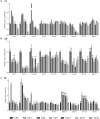Improvement of hybrid grouper (Epinephelus fuscoguttatus ♀ × E. lanceolatus ♂) by enzyme-digested poultry by-product: Growth performance, amino acid and peptide transport capacity, and intestinal morphology
- PMID: 35928839
- PMCID: PMC9343992
- DOI: 10.3389/fnut.2022.955734
Improvement of hybrid grouper (Epinephelus fuscoguttatus ♀ × E. lanceolatus ♂) by enzyme-digested poultry by-product: Growth performance, amino acid and peptide transport capacity, and intestinal morphology
Abstract
Background: At present, fish meal (FM) resources are in short supply, and competition for food between humans and animals is becoming increasingly critical. Finding non-grain protein sources that can replace FM is the key to solving the rapid development of aquaculture.
Methods: Seven trial diets were prepared with 0 g/kg (EP0), 30 g/kg (EP3), 60 g/kg (EP6), 90 g/kg (EP9), 120 g/kg (EP12), 150 g/kg (EP15), and 180 g/kg (EP18) of enzyme-digested poultry by-product meal (EPBM) by replacing of FM. A total of 630 hybrid groupers (Epinephelus fuscoguttatus ♀ × E. lanceolatus ♂) were equally portioned into 21 tanks. At 8:00 and 16:00 each day, groupers were fed until they were full for a cumulative period of 8 weeks.
Results: The results showed that 30 g/kg of EPBM significantly increased the rates of weight gain and special growth (P < 0.05). Significantly higher activities of serum glutamic pyruvic transaminase, glutamic oxaloacetic transaminase, catalase, and superoxide dismutase were observed in the EP3 group (P < 0.05). The categories and numbers of the top 10 dominant bacteria in the phylum and genus levels were not significantly influenced by feed (P > 0.05). In the proximal intestine and distal intestine, there were significantly higher expressions of SNAT3, LAAT1, CAT2, and CAT1 in the EP3 group compared with the EP0 group (P < 0.05). In the EP3 group, the expressions of PepT1, LAAT1, B0, +AT, and CAT2 were significantly increased in MI than those in all other groups (except the EP0 group, P < 0.05).
Conclusion: When FM was replaced by 30 g/kg of EPBM, growth performance, antioxidant capacity, and the ability to transport amino acids and peptides of hybrid grouper were significantly improved.
Keywords: amino acid and peptide transporters; enzyme-digested poultry by-product meal; growth performance; hybrid grouper; intestinal microbiota; non-specific immunity.
Copyright © 2022 Yang, Zhao, Wang, Dong, Yang, Liu, Zhang, Tan and Chi.
Conflict of interest statement
XZ and GW were employed by Yichang Huatai Biological Technology Co., Ltd., Yichang, China. The remaining authors declare that the research was conducted in the absence of any commercial or financial relationships that could be construed as a potential conflict of interest.
Figures








Similar articles
-
The effect of partial replacement of fish meal by soy protein concentrate on growth performance, immune responses, gut morphology and intestinal inflammation for juvenile hybrid grouper (Epinephelus fuscoguttatus ♀ × Epinephelus lanceolatus ♂).Fish Shellfish Immunol. 2020 Mar;98:619-631. doi: 10.1016/j.fsi.2019.10.025. Epub 2019 Nov 5. Fish Shellfish Immunol. 2020. PMID: 31704202
-
Substituting fish meal with castor meal in diets of hybrid grouper (Epinephelus fuscoguttatus♀ × E. lanceolatus♂): Effects on growth performance, immune response, antioxidant and digestive enzyme activities, gut morphology, and inflammatory-related gene expression.Fish Shellfish Immunol. 2022 Dec;131:181-195. doi: 10.1016/j.fsi.2022.10.003. Epub 2022 Oct 4. Fish Shellfish Immunol. 2022. PMID: 36206996
-
Dietary vitamin A deficiency reduces growth performance, immune function of intestine, and alters tight junction proteins of intestine for juvenile hybrid grouper (Epinephelus fuscoguttatus ♀ × Epinephelus lanceolatus ♂).Fish Shellfish Immunol. 2020 Dec;107(Pt A):346-356. doi: 10.1016/j.fsi.2020.10.016. Epub 2020 Oct 14. Fish Shellfish Immunol. 2020. PMID: 33068761
-
Effects of fishmeal replacement by black soldier fly on growth performance, digestive enzyme activity, intestine morphology, intestinal flora and immune response of pearl gentian grouper (Epinephelus fuscoguttatus ♀ × Epinephelus lanceolatus ♂).Fish Shellfish Immunol. 2022 Jan;120:497-506. doi: 10.1016/j.fsi.2021.12.027. Epub 2021 Dec 21. Fish Shellfish Immunol. 2022. PMID: 34942373
-
The positive effects of dietary inositol on juvenile hybrid grouper (♀ Epinephelus fuscoguttatus × ♂ E. lanceolatu) fed high-lipid diets: Growthperformance, antioxidant capacity and immunity.Fish Shellfish Immunol. 2022 Jul;126:84-95. doi: 10.1016/j.fsi.2022.05.016. Epub 2022 May 13. Fish Shellfish Immunol. 2022. PMID: 35577318
Cited by
-
Methanotroph (Methylococcus capsulatus) bacteria meal, influences the intestinal microbiome, and improves intestinal barrier function and immunity in hybrid grouper (Epinephelus fuscointestinetatus ♀ × E. lanceolatus ♂).Anim Nutr. 2025 Jul 12;22:321-336. doi: 10.1016/j.aninu.2025.03.020. eCollection 2025 Sep. Anim Nutr. 2025. PMID: 40896489 Free PMC article.
References
-
- Olsen RL, Hasan MR. A limited supply of fishmeal: impact on future increases in global aquaculture production. Trends Food Sci Tech. (2012) 27:120–8. 10.1016/j.tifs.2012.06.003 - DOI
-
- Wu YB, Ren X, Chai XJ, Li P, Wang Y. Replacing fish meal with a blend of poultry by-product meal and feather meal in diets for giant croaker (Nibea japonica). Aquacult Nutr. (2018) 24:1085–91. 10.1111/anu.12647 - DOI
-
- Rhodes MA, Zhou Y, Salze GP, Hanson TR, Davis DA. Development of plant-based diets and the evaluation of dietary attractants for juvenile Florida pompano, Trachinotus carolinus L. Aquacult Nutr. (2017) 23:1065–75. 10.1111/anu.12474 - DOI
-
- Fournier V, Huelvan C, Desbruyeres E. Incorporation of a mixture of plant feedstuffs as substitute for fish meal in diets of juvenile turbot (Psetta maxima). Aquaculture. (2004) 236:451–65. 10.1016/j.aquaculture.2004.01.035 - DOI
LinkOut - more resources
Full Text Sources
Miscellaneous

